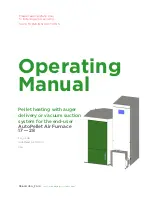
035-17477-002 Rev. D (1202)
Unitary Products Group
7
DUCTWORK
The duct system's design and installation must:
1.
Handle an air volume appropriate for the served space
and within the operating parameters of the furnace spec-
ifications.
2.
Be installed in accordance with standards of NFPA
(National Fire Protection Association) as outlined in
NFPA pamphlets 90A and 90B (latest editions) or appli-
cable national, provincial, local fire and safety codes.
3.
Create a closed duct system. The supply duct system
must be connected to the furnace outlet and the return
duct system must be connected to the furnace inlet. Both
supply and return duct systems must terminate outside
the space containing the furnace.
4.
Complete a path for heated or cooled air to circulate
through the air conditioning and heating equipment and
to and from the conditioned space.
When the furnace is used in conjunction with a cooling coil,
the coil must be installed parallel with, or in the supply air side
of the furnace to avoid condensation in the primary heat
exchanger.
When a parallel flow arrangement is used, the dampers or
other means used to control air flow must be adequate to pre-
vent chilled air from entering the furnace, and if manually
operated, must be equipped with means to prevent operating
of either unit unless the damper is in the full heat or cool posi-
tion.
UPFLOW MODELS
SUPPLY PLENUM CONNECTION
Attach the supply plenum to the fur-
nace outlet duct connection flanges.
This is typically through the use of S
cleat material when a metal plenum is
used. The use of an approved flexible
duct connector is recommended on all
installations. This connection should be
sealed to prevent air leakage.
If a matching cooling coil is used, it
may be placed directly on the furnace
outlet and sealed to prevent leakage.
Follow the coil instructions for installing
the supply plenum.
On all installations without a coil, a removable access panel
is recommended in the outlet duct such that smoke or
reflected light would be observable inside the casing to indi-
cate the presence of leaks in the heat exchanger. This
access cover shall be attached in such a manner as to pre-
vent leaks.
RETURN DUCT CONNECTION
Return air may enter the furnace through the side(s) or bot-
tom depending on the type of application.
Return air may
not be connected into the rear panel of the unit.
Refer to
the "Filter Installation" section of this instruction for the type of
application desired for specific installation details.
NOTE:
In order to achieve the airflow indicated in the table, it
is recommended those applications over 1800 CFM use
return air from two sides, one side and the bottom or bottom
only. For single return application, see data and notes on
blower performance data tables in this manual.
Table 3:
UNIT CLEARANCES TO COMBUSTIBLES
APPLICATION
TOP
FRONT
REAR
LEFT
SIDE
RIGHT
SIDE
FLUE
FLOOR/
BOTTOM
CLOSET
ALCOVE
ATTIC
LINE
CON-
TACT
UPFLOW MODELS (P*UR / G9T-UP / FG9-UP)
UPFLOW
1
3
0
0
0
0
COMBUSTIBLE
YES
YES
YES
NO
DOWNFLOW / HORIZONTAL MODELS (P*DH / G9T-DH / FG9-DH )
DOWNFLOW
1
3
0
0
0
0
1"
*
YES
YES
YES
NO
HORIZONTAL
1
3
0
0
†
0
†
0
1”
NO
YES
YES
YES
‡
*.
Special floor base or air conditioning coil required for use on combustible floor.
†.
Minimum of 8” clearance required to install condensate removal system.
‡.
Line contact only permitted between lines formed by the intersection of the rear panel and side panel (top in horizontal position) of
the furnace jacket and building joists, studs or framing.
The cooling coil must be installed in the supply air
duct downstream of the furnace. Cooled air must
not be passed over the heat exchanger.



































